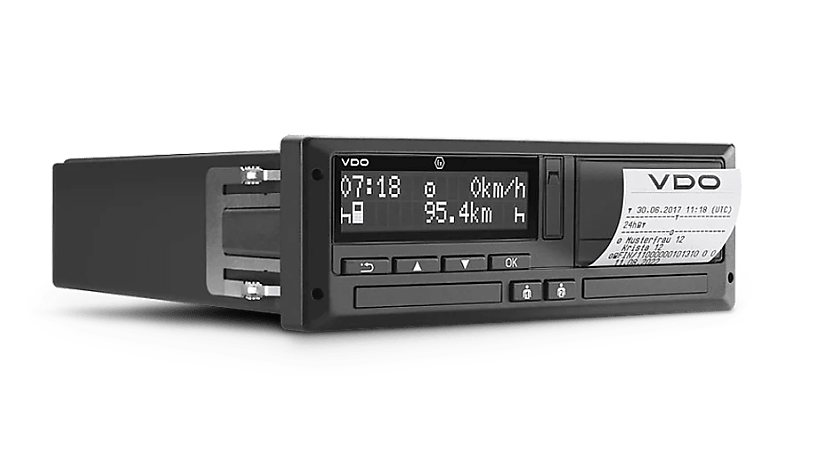Starting in August 2023, new developments in smart tachograph legislation will impact how fleets manage compliance with drivers’ hours. To help fleets prepare for the revised rules, we’ll explain the upcoming changes and list key dates. Context is important when it comes to smart tachograph legislation. So, we’ll first review what a smart tachograph does.
What is a smart tachograph?
Tachograph devices have been around for several decades, with the first analogue devices being used in the 1950s. It’s worth noting that since 2005, all qualifying vehicles produced within the EU are required to have a tachograph installed.
Per tachograph regulations from June 2019, every new vehicle must have a smart tachograph installed. Like their predecessors, smart tachographs record a driver’s mileage, driving speed and non-working hours. The purpose of the smart tachograph remains the same as the analogue version: to ensure driver well-being and increase road safety.
As digital devices, smart tachographs offer a range of advanced features, from enhanced security and improved efficiency to an open interface for additional services. One major advantage of the smart tachograph is the dedicated short-range communication system, which streamlines fleet inspections.
Why is smart tachograph version 2 mandatory?
Recent developments in legislation have led to the latest version of smart tachograph, called version 2. In April 2020, the European Parliament adopted legislative reforms aimed at improving driver working conditions, establishing clear rules on the posting of drivers and boosting fair competition in the transport sector. These legislative changes are referred to as Mobility Package 1, which states that:
- Drivers cannot spend their 45-hour rest periods in their cabs. Transport companies must plan schedules that enable international drivers to go home on a regular basis.
- Tachographs will be used to register border crossings, to bolster fair competition and hamper fraud. To prevent systematic cabotage operations, there will be a mandatory cooling off period of four days. EU laws for transport operators will apply to all vehicles over 2.5 tonnes, requiring the installation of tachographs.
- Equal pay for drivers will replace national wage schemes.
Smart tachograph version 2 will support enforcement of the EU’s legislative updates. Fleets should follow the key dates outlined by the European Commission:
- As of August 2023, newly registered vehicles will have smart tachograph version 2 installed.
- For registered vehicles involved in international road transport operations, version 2 installation is mandatory by August 2025 at the latest, with a deadline of 31 December 2024 for vehicles equipped with non-smart tachographs, and 18 August 2025 for those with smart tachograph version 1.
- From 1 July 2026 onward, all vehicles that weigh over 2.5 tons and which are used for international road transport or cabotage operations must have smart tachograph version 2.
What’s new in smart tachograph version 2?
In addition to registering border crossings, version 2 will log when a vehicle is being loaded or unloaded. Other new features of version 2 include strengthened anti-tampering mechanisms.
Fleets will be able to store driver-related data from smart tachograph version 2 for 56 days, twice the time allowed for version 1. The doubled storage time results in greater visibility—fleet managers will have an easier time monitoring driver hours and rest periods to ensure breaks are taken. Plus, regular software updates mean that fleet operators can count on tachograph consistency across their business.
For instance, fleet managers can use registered start times to remotely verify that drivers began their shifts on time. Fleet managers, in other words, don’t need to be physically present at the depot to confirm driver start times. Plus, quick access to remaining driving hours makes daily and weekly job planning much easier.
Smart tachograph version 2 is designed to be more efficient, secure and compatible with modern technologies compared to their predecessors. As a result, fleets will be well-positioned to take advantage of their tachograph data.
The role of telematics in managing tachograph data
Compliance can be a headache for fleet managers. After all, failure to comply with regulations on drivers’ hours could lead to financial penalties, prosecution or loss of an operating license. Manual downloads can eat up quite a bit of time—and come loaded with admin hassles. A digital tachograph telematics solution provides peace of mind by automating compliance and eliminating manual admin tasks.

That’s why fleets choose solutions like Webfleet’s Tachograph Manager, which simplifies compliance with remote data downloads, a secure archive and comprehensive analysis. Extensive reports give an overview of expected fines, social infringements and advice to support driver compliance.
When it comes to compliance, quality of data is everything. Looking for a reliable solution to simplify tachograph downloads and stay ahead of compliance deadlines? Request a free consultation with one of our tachograph experts, who will be happy to answer questions and provide a demo.








